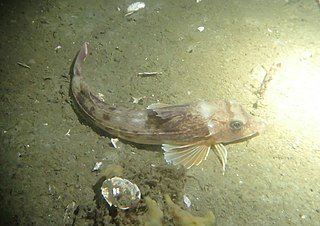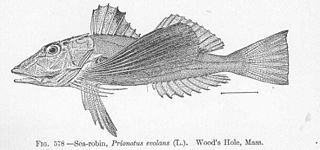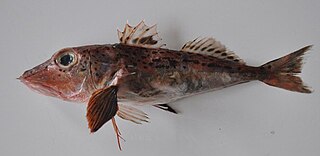
Triglidae, commonly known as gurnards or sea robins, are a family of bottom-feeding scorpaeniform ray-finned fish. The gurnards are distributed in temperate and tropical seas worldwide.

Peristediidae, the armored sea robins or armoured gurnards, is a family of ray-finned fishes belonging to the suborder Platycephaloidei in the order Scorpaeniformes. They are found in the deep water in the tropical and warm temperate of the world's oceans.

The tub gurnard, also known as the sapphirine gurnard, tube-fish, tubfish or yellow gurnard, is a is a species of marine ray-finned fish belonging to the family Triglidae, the gurnards and sea robins. It is found in the eastern Atlantic Ocean. It is exploited by commercial fisheries as a food fish.

Bellator militaris, the horned sea robin, is a species of marine ray-finned fish belonging to the family Triglidae, the sea robins. This fish is found in the western Atlantic Ocean.

The spiny red gurnard is a species of marine ray-finned fish belonging to the family Triglidae, the gurnards and sea robins. This species is found in the northwestern Pacific Ocean where they occur at depths of from 25 to 615 metres. This species grows to a length of 40 centimetres (16 in) TL. This species is of commercial importance as a food fish.

Bellator is a genus of marine ray-finned fishes belonging to the family Triglidae, one of two genera belonging to the subfamily Prionotinae, the sea robins. These fishes are found in the Western Atlantic Ocean and eastern Pacific Ocean, in the waters off both North and South America.

Bellator egretta, the streamer searobin, is a species of marine ray-finned fish belonging to the family Triglidae, the sea robins. This fish is found in the western Atlantic Ocean.

The grey gurnard is a species of ray-finned fish from the family Triglidae, the gurnards and sea robins. It is native to the eastern Atlantic Ocean, the Mediterranean Sea, and the Black Sea. It is caught as a food fish and is known for producing sounds. It is the only member of the monotypic genus Eutrigla.

Lepidotrigla is a genus of marine ray-finned fishes belonging to the family Triglidae, the gurnards and sea robins. These gurnards are found in the Eastern Atlantic, Indian and Western Pacific Oceans.

Pterygotrigla is a genus of genus of marine ray-finned fishes belonging to the family Triglidae, the gurnards and sea robins, one of two genera belonging to the subfamily Pterygotriglinae. These gurnards are found in the Indian and Pacific oceans.

The red gurnard, also known as the East Atlantic red gurnard or soldier, is a benthic species of ray-finned fish belonging to the family Triglidae, the gurnards and sea robins. This fish is found in the eastern Atlantic Ocean, including the Mediterranean Sea and the Black Sea.

Platycephaloidei is a suborder of ray-finned fishes, part of the order Scorpaeniformes, and includes the flatheads, ghost flatheads and sea robins.

Peristedion is a genus of marine ray-finned fish belonging to the family Peristediidae, the armoured gurnards or armored sea robins. These fishes are found in Atlantic and Indo-West Pacific ocean waters.
Prionotus evolans, the striped searobin, is a species of marine ray-finned fish belonging to the family Triglidae, the sea robins. This fish is found in the western Atlantic Ocean.

Prionotinae is a subfamily of demersal, marine ray-finned fishes, part of the family Triglidae. The fishes in this subfamily are called sea robins and are found in the Western Atlantic and Eastern Pacific Oceans, the other two Triglid subfamilies are called gurnards.

Pterygotriglinae is a subfamily of demersal, marine ray-finned fishes, part of the family Triglidae, the gurnards and searobins. These gurnards are found in the Indo-Pacific region.

Pterygotrigla arabica is a species of ray-finned fish belonging to the family Triglidae, the gurnards and sea robins. This fish is found in the northern Indian Ocean.
Pterygotrigla multiocellata, the antrorse spined gurnard, is a species of ray-finned fish belonging to the family Triglidae, the gurnards and sea robins. This fish is found in the Indo-Pacific region where it has been recorded from Japan, Saipan, and the eastern and western tropical waters off Australia.

Triglinae is a subfamily of demersal, marine ray-finned fishes, part of the family Triglidae, the gurnards and searobins. These gurnards are found in all the tropical and temperate oceans of the world except for the Western Atlantic Ocean.

The blackspotted gurnard, also known as the half-spotted gurnard, is a species of marine ray-finned fish belonging to the family Triglidae, the gurnards and sea robins. It is found in the Indo-Pacific region.

















